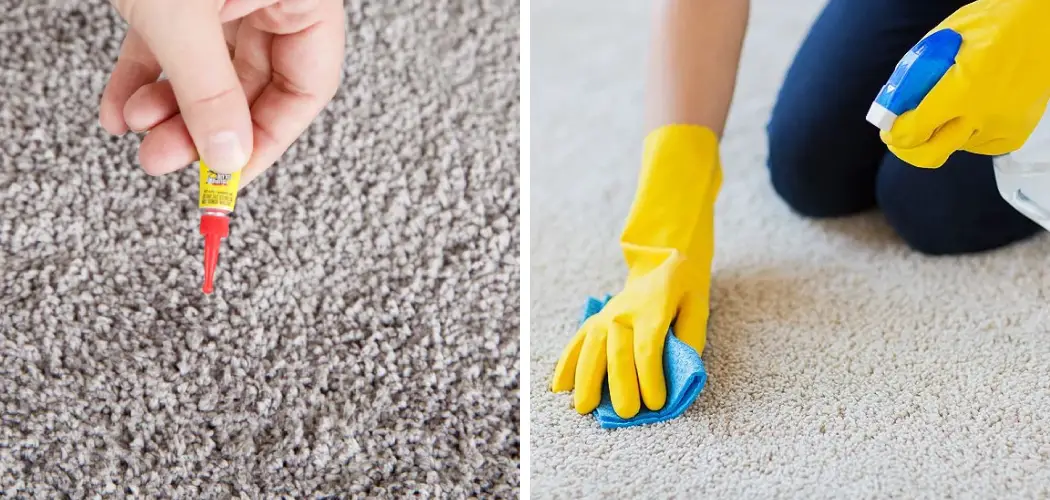Are you stuck with dried superglue on your carpet? Don’t worry; it may seem like a difficult task, but some simple methods can help you get rid of the stubborn glue.
Discovering dried super glue on your carpet can be a homeowner’s nightmare, turning a seemingly simple accident into a daunting challenge. Super glue, known for its strong bond and quick-drying properties, can adhere to carpet fibers, making removal impossible. However, with the right approach and patience, removing dried superglue and restoring your carpet to its former condition is possible.
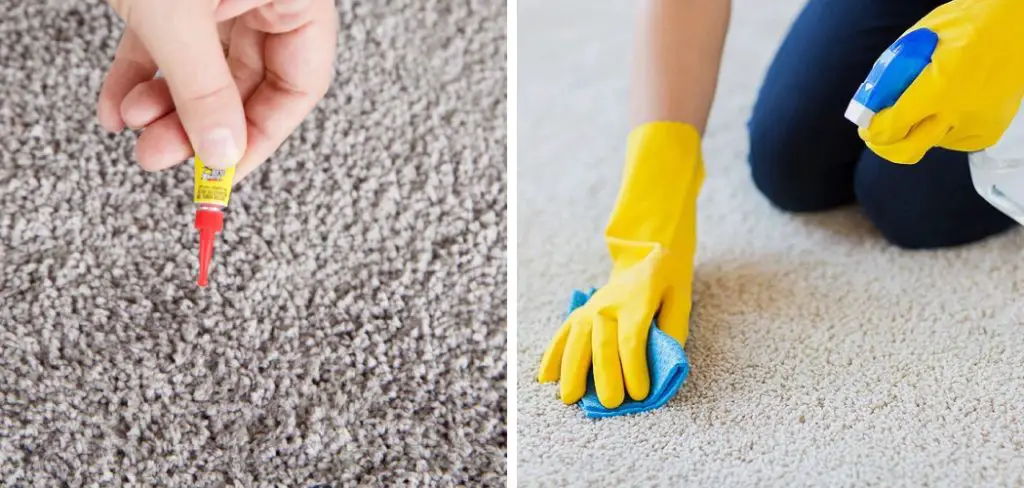
This guide on how to get dried super glue out of carpet will walk you through the necessary steps and provide helpful tips to tackle this tricky situation effectively, ensuring your carpet remains unharmed in the process.
What are the Consequences of Not Removing Dried Super Glue from Carpet?
Before diving into the methods of removing dried superglue from the carpet, it’s important to understand why it’s essential to do so.
Not removing dried super glue from the carpet can have short-term and long-term consequences. Short-term, it can make your carpet look unsightly and stained. This is especially true if the glue is in a visible area, such as your living room or hallway. It can also create a rough and uncomfortable surface, making it unpleasant to walk on.
In the long term, not removing dried super glue can cause damage to your carpet fibers over time. The glue’s strong bond can weaken the fibers, resulting in fraying and potentially leading to permanent damage. Additionally, the glue can attract dirt and debris, making it harder to clean your carpet in the future. Therefore, it’s crucial to remove dried superglue from your carpet as soon as possible.
What Will You Need?
Before removing dried superglue from your carpet, gathering all the necessary supplies is important. Some of these items can likely be found in your home, while others may need to be purchased. Here’s a list of things you will need:
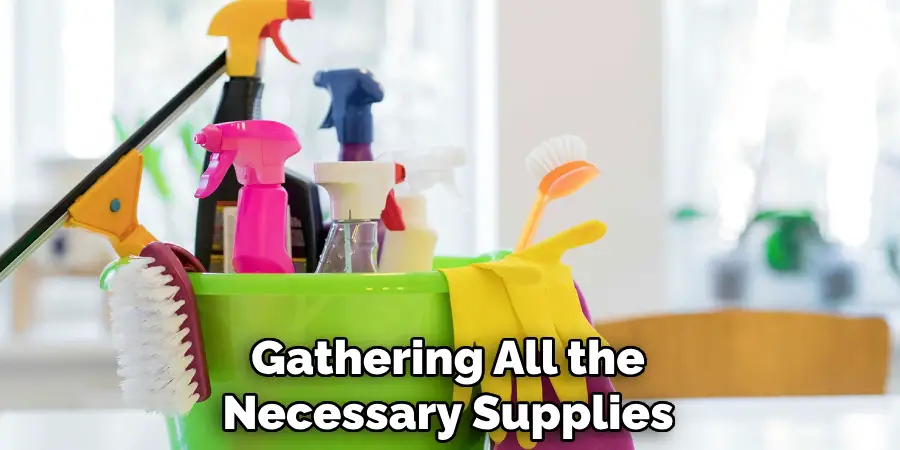
- Razor blade or scraper
- White vinegar
- Warm water
- Dish soap
- Stiff bristle brush
- Clean cloths or paper towels
- Rubbing alcohol
- Carpet cleaner (optional)
10 Easy Steps on How to Get Dried Super Glue Out of Carpet
Step 1. Scraping Off:
Begin by gently scraping off as much of the dried superglue as possible using a razor blade or scraper. Be careful not to cut or damage the carpet fibers. Aim to remove the bulk of the glue without applying too much pressure. Also, avoid using sharp objects such as scissors, which can cause further damage.
Step 2. Applying Warm Vinegar:
After scraping off the dried super glue, prepare a solution of warm water and white vinegar in equal parts. Dampen a clean cloth or paper towel with this mixture and place it directly on the affected area. Allow it to sit for about 15 minutes. The acidity in the vinegar helps soften the glue, making it easier to remove without harming the carpet’s fibers. Remember to test the vinegar solution on a small, inconspicuous area of the carpet first to ensure it doesn’t cause discoloration.
Step 3. Blotting and Scrubbing:
Once the vinegar solution has had time to work, gently blot the area with a clean cloth or paper towel. Do not rub vigorously, as this can push the glue deeper into the carpet fibers or cause the fibers to fray. Following blotting, take a stiff bristle brush and lightly scrub the area to loosen any remaining glue. Scrub gently circularly to avoid damaging the carpet, gradually working the glue out of the fibers.
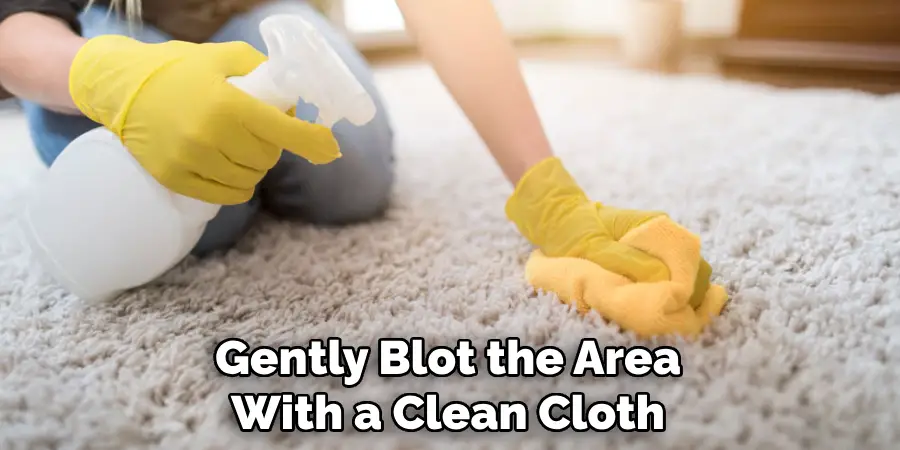
Step 4. Rinsing with Dish Soap Solution:
Create a mild cleaning solution by mixing a few drops of dish soap with warm water. Dampen a clean cloth with the solution and gently dab it onto the area to rinse out the vinegar and any remaining glue residue. This step helps to break down the glue’s bond further while ensuring that the vinegar does not damage or bleach the carpet. Rinse the area by blotting with a cloth dampened in clean water to remove soap residue. Pat the area dry with a clean towel or paper towel to absorb excess moisture.
Step 5. Applying Rubbing Alcohol:
If the super glue persists after using vinegar and dish soap, apply a small amount of rubbing alcohol to a clean cloth or paper towel. Gently dab the alcohol onto the glue spot, avoiding saturating the carpet. The alcohol acts as a solvent to weaken the glue’s bond with the carpet fibers. Allow it to sit for a few minutes before blotting again with a clean, dry cloth to remove the loosened glue. Always perform a spot test in an inconspicuous area before broadly applying alcohol to ensure it does not discolor the carpet.
Step 6. Repeating as Necessary:
Repeat the aforementioned steps as necessary, starting from the application of warm vinegar to the use of rubbing alcohol. Each repetition may help to soften and break down the glue residue further. It’s important to be patient and persistent, as removing superglue can sometimes require multiple attempts. Ensure each step is performed gently to minimize the risk of damaging the carpet fibers. Eventually, the combination of vinegar, dish soap solution, and rubbing alcohol should dissolve the bond of the glue sufficiently to delete it.
Step 7. Drying the Area:
After you have successfully removed the super glue, it’s crucial to thoroughly dry the area. Use clean, dry cloths or paper towels to blot the carpet, absorbing as much moisture as possible. Then, if available, use a fan or hairdryer on a low heat setting to accelerate the drying process. Ensure the carpet is completely dry before allowing foot traffic in the area. This step helps prevent any moisture-related issues, such as mold or mildew, preserving the quality and longevity of your carpet.
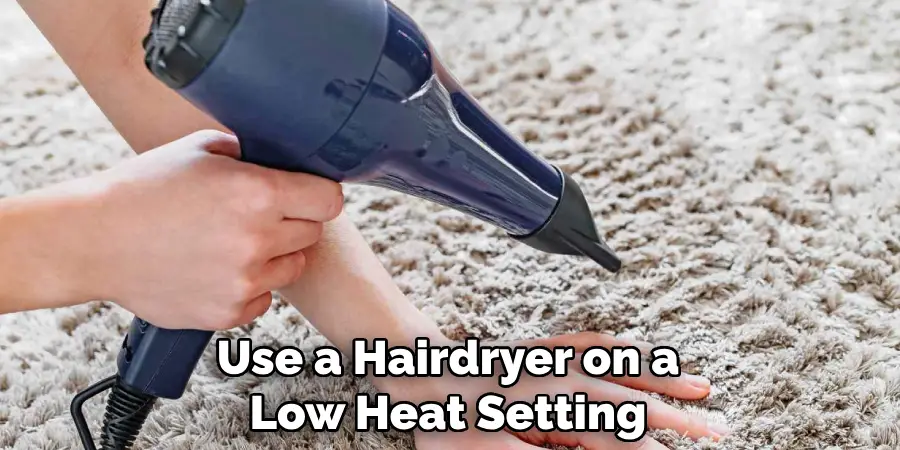
Step 8. Checking for Color and Texture Restoration:
Once the area is dry, it’s important to check the carpet for any changes in color or texture. If the carpet appears discolored or the fibers seem damaged or altered in texture, there may be some additional steps you can take. For slight discoloration, a carpet cleaner designed for your type of carpet may help restore the original color. If the texture of the fibers has changed, gently brushing the area with a soft-bristled brush can help realign and fluff the fibers back to their normal state. It’s essential to approach this step carefully to avoid causing further damage to the carpet.
Step 9. Applying Carpet Cleaner for Deep Cleaning (Optional):
Consider using a carpet cleaner specifically designed for your carpet type for stubborn glue stains that persist or areas where discoloration remains. Apply the carpet cleaner according to the manufacturer’s instructions, using a clean cloth or carpet cleaning machine if required. This step aims to target any lingering glue residue and refresh the area, removing any vinegar, soap, or alcohol smells and ensuring the carpet regains its original appearance and texture. Test the cleaner on a small, inconspicuous area first to ensure it does not adversely affect the carpet colors or fibers.
Step 10. Final Inspection and Vacuuming:
After the area has dried completely and you’ve applied any necessary cleaning treatments, conduct a final inspection of the carpet. Look for any lingering glue residue or signs of discoloration. If the carpet appears clean and restored, use a vacuum cleaner to go over the treated area. This helps to lift the carpet fibers, restoring their natural fluffiness and ensuring that no cleaning residues remain. Vacuuming not only enhances the appearance of your carpet but also promotes a healthier environment by removing any microscopic particles that may have settled during the cleaning process.
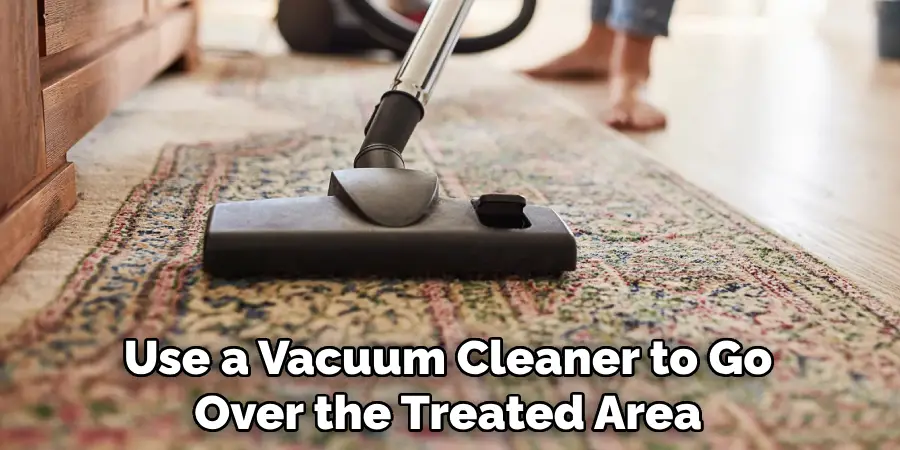
By following these steps and using readily available household items, you can effectively remove super glue from your carpet without causing damage to the fibers.
5 Additional Tips and Tricks
- Act Quickly: The sooner you can address the spilled super glue, the better. While the above steps can work on dried glue, fresh spills are always easier to manage. Quick action can prevent the glue from deeply setting into the carpet fibers.
- Use Ice to Harden the Glue: For smaller glue spots, apply an ice cube or an ice pack wrapped in a thin cloth over the glue for several minutes. This will harden the glue, making it easier to gently scrape off with a knife or a spoon without spreading it further into the carpet fibers.
- Professional Strength Solvent: If DIY methods are not effective, consider purchasing a professional-grade solvent designed for super glue removal. Make sure to follow the directions closely and always perform a patch test in an inconspicuous area first to ensure it doesn’t damage the carpet.
- Maintain Good Ventilation: When using substances like vinegar, dish soap, or rubbing alcohol, ensure the room is well-ventilated. Open windows and doors or use a fan to circulate air and dissipate fumes, making the process safer and more comfortable.
- Consult a Professional: If the glue does not come out or you are unsure about using certain products on your type of carpet, it might be best to call a professional carpet cleaner. They have the experience and the equipment necessary to safely remove stubborn stains without damaging your carpet.
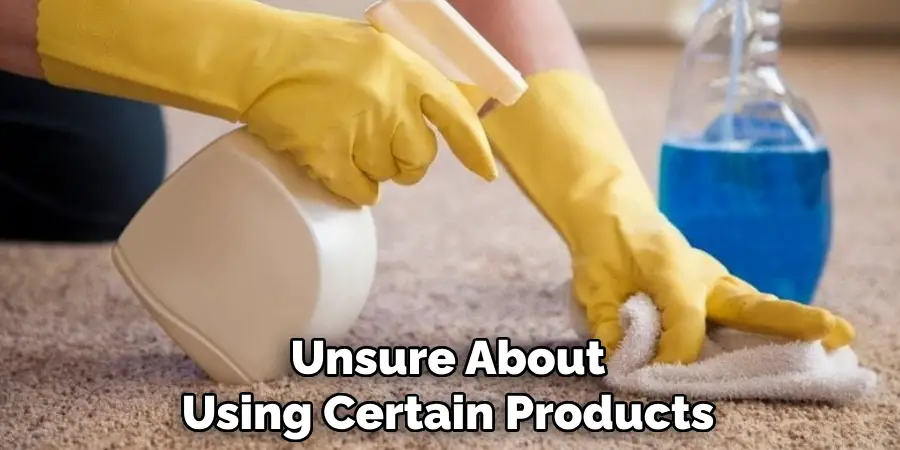
By incorporating these additional tips and tricks, you can enhance your approach to removing dried super glue from carpets, potentially saving time and ensuring the maintenance of your carpet’s appearance and texture.
5 Things You Should Avoid When Trying to Get Dried Super Glue Out of Carpet
- Avoid Using Sharp or Metal Tools: Scraping the carpet with sharp objects, such as knives or scissors, may seem like an immediate solution, but it can seriously damage the carpet fibers. Always opt for a blunt tool or the edge of a spoon when attempting to remove the glue.
- Steer Clear of High Heat: While heat can be useful in certain cleaning contexts, applying high heat directly to super glue can cause it to further bond with the carpet fibers. Avoid using irons or hairdryers on high settings, as this might worsen the situation.
- Don’t Use Colored Cloths or Sponges: When applying any liquid solution to your carpet, ensure you use white or non-colored cloths and sponges. Colored materials can transfer dyes onto the carpet, creating a new stain on top of the glue residue.
- Avoid Harsh Chemicals: While using strong chemicals to dissolve super glue is tempting, many of these can discolor your carpet or harm its fibers. Always opt for milder solutions and test them in an inconspicuous area first.
- Do Not Saturate the Carpet: Applying too much liquid, whether cleaning solution or water, can seep deep into the carpet and its backing, leading to mold and mildew. Always use the minimum amount of necessary liquid and dry the area thoroughly afterward.
By avoiding these common mistakes, you can effectively remove superglue from your carpet without causing further damage.
Does Vinegar Damage Carpet?
The common misconception is that vinegar can damage carpets due to its acidic nature. However, when used correctly and in small amounts, vinegar can be an effective natural cleaning solution for many types of carpets. Diluting white distilled vinegar with water (in a 1:1 ratio) creates an all-purpose cleaner that effectively removes stains and odors from carpets.
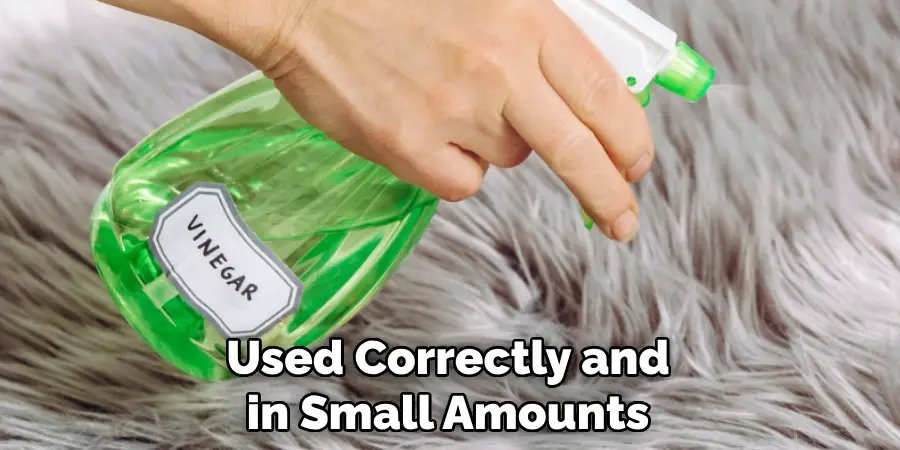
Vinegar breaks down and dissolves substances like glue, making it a useful ingredient in removing super glue from carpets. To ensure that vinegar does not damage your carpet, always perform a patch test on an inconspicuous area first before applying it to the stained area.
While vinegar is generally safe for most types of carpets, it’s important to note that some natural fiber carpets, such as wool or silk, may be more sensitive to its acidic properties. In these cases, it’s best to consult a professional cleaner before using vinegar as a cleaning solution.
What Happens if You Leave Baking Soda on Carpet Overnight?
As a natural deodorizer and stain remover, baking soda has long been used as an effective cleaning agent for carpets. Leaving it on overnight can enhance its cleaning power by allowing it to penetrate deeper into the carpet fibers.
The most common way to use baking soda for carpet cleaning is by combining it with vinegar or dish soap to create a paste. Once applied to the stained area, let it sit for a few minutes before using a damp cloth to gently scrub the mixture into the carpet. Letting this mixture sit overnight can help break down and lift tough stains and odors.
It’s important to note that leaving baking soda on your carpet for too long may cause discoloration or damage, especially on natural fibers like wool or silk. Always test the mixture in an inconspicuous area and avoid leaving it on for more than a few hours. Thoroughly vacuuming the carpet after using baking soda will remove all residue, leaving your carpet fresh and clean. Overall, as long as vinegar and baking soda are used correctly and in moderation, they should not cause any damage to your carpets.
What Absorbs Bad Smells in Carpet?
There are a few natural and readily available options for absorbing bad smells in carpets, such as baking soda, white vinegar, and activated charcoal. These substances work to neutralize odors by absorbing them rather than simply masking them.
Baking soda is one of the most commonly used odor absorbers for carpets. Its fine particles can penetrate deep into the fibers, absorbing and eliminating odors. Simply sprinkle a generous amount of baking soda over the affected area, let it sit for at least 30 minutes (overnight for more stubborn smells), and then vacuum it thoroughly.
White vinegar is another effective odor absorber, particularly for pet odors. Dabbing a mixture of equal parts white vinegar and water onto the carpet and letting it dry can help remove any lingering smells.
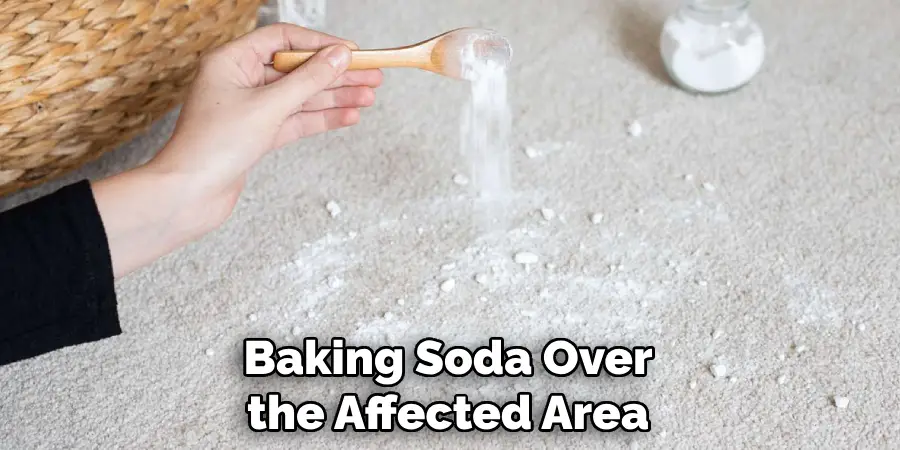
Activated charcoal is a highly porous substance that can absorb and trap odors effectively. Simply sprinkle some over the affected area, let it sit for a few hours, and then vacuum it up.
In addition to using these natural odor absorbers, regularly vacuuming your carpet and maintaining proper ventilation in your home can also help prevent bad smells from staying in your carpet.
Conclusion
Removing dried super glue from your carpet requires patience, careful technique, and the right approach. By following the steps outlined, such as gently scraping away the glue, applying acetone or rubbing alcohol, and avoiding common pitfalls like using sharp tools or harsh chemicals, you can effectively tackle this household challenge.
Remember, each carpet is unique, and what works for one might not work for another. It’s crucial to proceed cautiously, test solutions on inconspicuous areas first, and prioritize your carpet’s integrity over quick fixes. With the correct method and a bit of effort, getting dried super glue out of your carpet can be a manageable task, leaving your floors looking clean and well-maintained.
Hopefully, the article on how to get dried super glue out of carpet has been helpful and informative. Happy cleaning!

